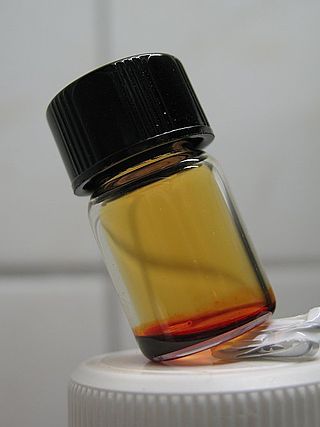Top Qs
Timeline
Chat
Perspective
Chromyl chloride
Chemical compound From Wikipedia, the free encyclopedia
Remove ads
Chromyl chloride is an inorganic compound with the formula CrO2Cl2 and is the formal dichloride of chromic acid. It is a reddish brown compound that is a volatile liquid at room temperature, which is unusual for transition metal compounds.[3]
Remove ads
Preparation
Chromyl chloride can be prepared by the reaction of potassium chromate or potassium dichromate with hydrogen chloride in the presence of concentrated sulfuric acid, followed by distillation.[4][5]
- K2Cr2O7 + 6 HCl → 2 CrO2Cl2 + 2 KCl + 3 H2O
The sulfuric acid serves as a dehydration agent. This reaction, the chloride test, gives a strikingly red product. It was once used as a test for chloride. No similar compound is formed in the presence of fluoride, bromide, iodide, or cyanide, making this test specific to chlorides.
It can also be prepared directly by exposing chromium trioxide to anhydrous hydrogen chloride gas.
- CrO3 + 2 HCl ⇌ CrO2Cl2 + H2O
When trityl chloride is used in place of HCl, the products are CrO2Cl2 and the alkoxides CrO2Cl(OCPh3) and CrO2(OCPh3)2 (Ph = C6H5).[6]
Remove ads
Reactions
Chromyl chloride is a Lewis acid, and a highly aggressive oxidant. It reacts with cyclohexane to give chlorocyclohexane, chlorocyclohexanone, and other species.[7]
Chromyl chloride oxidizes internal alkenes to alpha-chloroketones or related derivatives.[8] It will also attack benzylic methyl groups to give aldehydes via the Étard reaction. Dichloromethane is a suitable solvent for these reactions.[9]
When treated with conventional Lewis bases, chromyl chloride forms adducts, such as CrO2Cl2(2,2'-bipy):[10]
- CrO2Cl2 + 2 L → CrO2Cl2L2
Remove ads
Safety considerations

Chromyl chloride is severely corrosive and easily burns the skin and eyes. It is a probable human carcinogen.[11]
References
External links
Wikiwand - on
Seamless Wikipedia browsing. On steroids.
Remove ads









